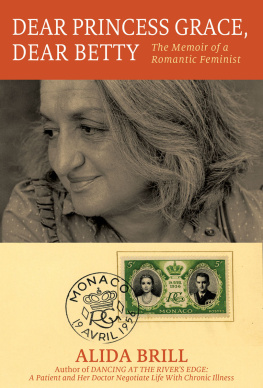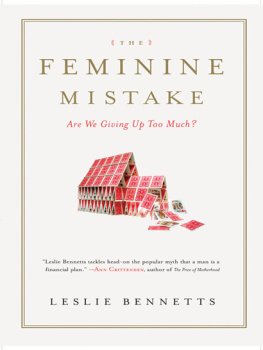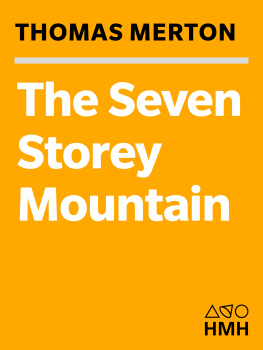
The Feminine Mystique
Betty Friedan

For all the new women,
and the new men
Contents
E very writer yearns to create a book that will seize the momentto perfectly encapsulate the problem of an era before other people even notice the problem exists. Of course, that almost never happens. Mostly, were happy if we can just manage to explain something people already know is going on in a rather interesting way. But Betty Friedan won the gold ring. When The Feminine Mystique emerged in 1963, it created a reaction so intense that Friedan could later write another book about the things women said to her about the first one ( It Changed My Life ). If theres a list of the most important books of the twentieth century, The Feminine Mystique is on it. It also made one conservative magazines exclusive roundup of the ten most harmful books of the 19th and 20th centuries, which if not flattering is at least a testimony to the wallop it packed.
Were still reading it today. In A Strange Stirring , her book about The Feminine Mystique and its impact, Stephanie Coontz writes that her students responded viscerally to chapters like The Sexual Sell that spoke to their own feelings of being under pressure to buy consumer goods and to present themselves as objects to be consumed. And of course, if you want to understand what has happened to American women over the last half-century, their extraordinary journey from Doris Day to Buffy the Vampire Slayer and beyond, you have to start with this book.
Criticsand many fansfeel obliged to point out the things that The Feminine Mystique ignores, and they are right to be a bit flummoxed that although Friedan was writing during the civil rights movement, she barely mentions African American women. Working-class women make their appearance mainly in a few suggestions that married women who want to work might want to hire a housekeeper or a nanny. And remarkably, Friedan managed to write a whole book indicting American society for its attitudes toward women without discussing its laws. In 1963, most women werent able to get credit without a male cosigner. In some states they couldnt sit on juries; in others, their husbands had control not only of their property but also of their earnings. Although Friedan obsesses about women getting jobs, she does not mention that newspapers were allowed to divide their Help Wanted ads into categories for men and women, or that it was perfectly legal for an employer to announce that certain jobs were for men only. Even the federal government did it.
In a strange way, all those deficits are the books strength. The Feminine Mystique is a very specific cry of rage about the way intelligent, well-educated women were kept out of the mainstream of American professional life and regarded as little more than a set of reproductive organs in heels. It is supremely, specifically personal, and thats what gives it such gut-punching power. Friedan had dropped out of her postgraduate studies because, she said, her academic success was threatening to her boyfriend. She was furious about the way the female college students of the next generation had been programmed to regard getting an MRS degree as the be-all and end-all of their experience in higher education. She was enraged by the way the psychiatric profession regarded housewives unhappiness as a symptom of an out-of-whack libido. She was angry at the way the economy appeared to see her entire sex as simple consumption machines who built national prosperity by buying new appliances for the kitchen and searching madly for the perfect laundry detergent. And dont get her started on womens magazines. Friedan wrote for womens magazines, and she piles up one astonishingly awful example of the selling of the feminine mystique after another. Theres one short story about a young woman who planned to be something, then married, wore out six copies of Dr. Spocks child-care book, and wound up declaiming: Im lucky! Lucky! IM SO GLAD TO BE A WOMAN! You really can envision the team from the mental hospital strapping her to a gurney.
Betty Friedan was born in 1921 and graduated from Smith College in the middle of World War II, so she watched with adult eyes when the postwar economy exploded, creating a mass middle class with a standard of living the planet had never before seen. By the time Friedan began writing her book, the majority of American families lived in homes they owned. They had cars and televisions, took vacations, and hoped to send their children to college. Jobs were easy to getso much so that desperate employers were plotting ad campaigns that might convince married women that a nice part-time clerical or sales gig would be an excellent way to make pin money for extras for the house and kids. (During one of The Feminine Mystique s attempts to nag its readers into returning to the world of work, Friedan mentions a friend, a suburban housewife who had once been a journalist but was afraid she had been out of the newspaper business too long to get back in the game. As it turned out, when she finally decided to do something about it, she found an excellent job in her old field after only two trips to the city, Friedan writes breezily. At this point we will have to pause while all the aspiring young reporters out there who are now on their third unpaid internship beat their heads against the wall.)
It was a remarkable moment, and perhaps the first time in American history that the average person had both the means and the leisure to ask herself whether she was really happy. Friedan wasnt.
The problem lay buried, unspoken, for many years in the minds of American women. It was a strange stirring, a sense of dissatisfaction, a yearning that women suffered in the middle of the twentieth century in the United States. Each suburban wife struggled with it alone, Friedan opened The Feminine Mystique . (Like almost all great books of the moment, it has an eternally quoted lead.) As she made the beds, shopped for groceries, matched slipcover material, ate peanut butter sandwiches with her children, chauffeured Cub Scouts and Brownies, lay beside her husband at nightshe was afraid to ask even of herself the silent questionis this all?
It sounds, in retrospect, a little whiny, but at the time it was an earthshaking query. For all of western history, average but ambitious women had dreamed of careers as full-time housewives. Working outside the home meant toiling in the fields, laboring in a factory or bar for a male employer or as a domestic for a female one. Being a stay-at-home housewife meant the chance for a woman to manage her own show. I guess I just liked the freedom of being at home and not having someone tell me what to do, a woman from Oklahoma once told me, explaining why she gave up her job as a bookkeeper to raise three children.
It was the promise of life as a full-time housewife that lured young Englishwomen to come to colonial Americajumping on very small boats to cross a very large ocean on the promise that they would find not just husbands but husbands who could set them up as stay-at-home wives. Often the recruitment propaganda wasnt truemost women who came to America found both husbands and lives that involved tilling the fields as well as spinning, sewing, cooking, canning, cheese making, candle making, and all the myriad manufacturing projects that were part of colonial house life. The work involved with keeping house was so enormous that even the women who were allowed to stay home full time were perpetually exhausted. The idea that they might have been able to run their own homes without hand laundering, soap making, chicken plucking, and all the other less than elevating parts of the job might have seemed like heaven itself.
Next page









